Contents
Welcome To The Best Steadicam
Do you have any videos where the recording seems somewhat blurry, jarring or shaky?
Of course you do. The average people who are not at all familiarized with steadicam technology have had the experience of taking shaky, jarring videos with a camcorder or their smartphones. This is fine when it comes to the typical amateur, but being a professional video maker requires more advanced technology in making videos.
The wobbles of a video or a film have been an inevitable part of recording in the past. When we move and shoot a video at the same time, the camera somehow manages to pick up every body movement or jolt, regardless of how hard we try to stay still.
This can be very annoying, especially if you are a professional cameraman. That is why a camera stabilizer has been introduced and nowadays movies have no shakes or jolts AT ALL. Why? Because the professional camera operators managed to find a solution and achieve this amazing effect. We now introduce you the Steadicam.
The Beginnings of Steadicam
First introduced in 1976, Steadicam and other camera stabilization tools became deeply infused in both the sports’ world and the filmmaking industry. After their introduction in video making, they have literally managed to expand the palette of every cinematographer and improve the experience of all of us who wish to watch a movie, football game or sports competition.
The brain of the person automatically works on adjusting the incoming information. This is why we do not always notice the movements or slight jolt through our body and how they somewhat ruin what we are filming. Our eyes smooth out the motion when it becomes disorienting and gives us a more fixated perspective of what we see. The camera does not have our abilities.
Certain cameras do include an adjustment mechanism that is built in to compensate for the shaking motion, but this is not a proper camera stabilizer. Actually, it does not even come close to the human brain system of stabilization. What we are left with is improper recording, filled with jolts and unsteadiness.
This is what encouraged Garrett Brown, a commercial producer and director, to begin working on video stabilizing system in the early 1970s. Brown actually wanted to get around the abovementioned limitations by building an alternative, highly portable camera stabilizer device that can isolate the operator from the camera, which in term would improve the balance of the video.
After many attempts, Brown accomplished his mission in 1973. This year was the one when the remarkably simple machine named ‘Brown’s Stabilizer’ was introduced. Later on, the exact same remarkable machine was renamed Steadicam.
The Steadicam was first used in 1976 in the Woody Gunthrie’s ‘Bound for Glory’. This first use of the machine managed to shoot a previously impossible shot that started from a fully elevated crane that jibbed down and reached the ground. Wexler actually got an Oscar in 1976 for best cinematography of the year.
After the amazing success of Steadicam in this movie, the interest started to grow fast. In the first few movies, the Steadicam operator remained Garrett Brown. For example, he was recording the chase and running scenes in Marathon Man that same year. Also, it landed third credit in Rocky (1976) where it recorded the street training sequences, the fights and the flight of stairs run up.
Nowadays, Steadicam is an absolute necessity for all those who want to make professional videos. Take for example the most famous Youtube vloggers with over 5 million subscribers like Adam Saleh and Casey Neistad. They all use hand held Steadicams. Even FouseyTube, with over 3.1 million Youtube subscribers decided to opt for this machine.
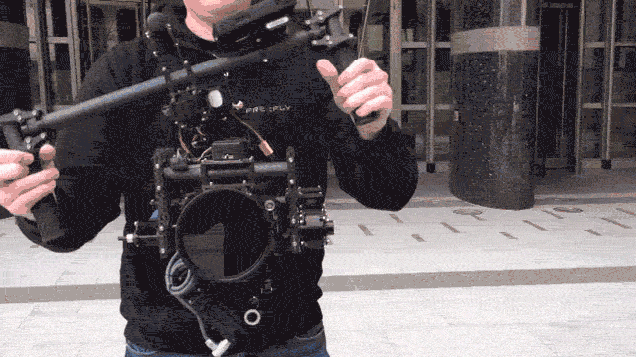
Steadicam Description
Generally speaking, there are three major elements that keep the camera steady:
- An iso-elastic arm
- A supportive vest
- Specialized sled, designed to hold the equipment for the camera
Being a cameraman makes it crucial for you to be introduced to this filming tool. Even if you are an assistant, newbie or trainee, working with Steadicam is something inevitable. Whatever your case is, it is time to cover the basics of how the Steadicam works.
Steadicam is designed to support maximum of 35 millimeters film, digital and IMAX cameras. When this machine is used, the operator wears a vest, attached to the iso-elastic arm and connected by ultra-low friction gimbal and a multiaxis. The armature on the other end holds the mounted camera on one and a weight for counterbalance on the other end. In most cases, this weight includes a monitor and battery pack.
The purpose of the monitor is to substitute as a viewfinder because when the camera moves quickly, it makes its own viewfinder completely or partially unusable. The small body movements the operator makes cannot move the armature because of the counterbalance and the placed camera. Additionally, the pivoting armature adds some stabilization to the video that is filmed or the photographed image.
Modes vs. Positions of Steadycam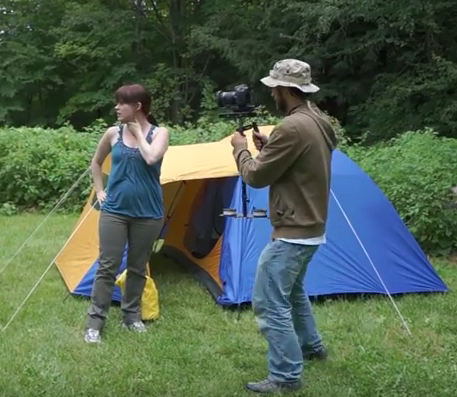
Modes of Steadicam
We will now take a deeper look in the difference between the two modes of Steadicam – low and high mode.
The high mode of Steadicam is the most common way cameramen use this machine. The camera is placed on top of the sled, at the height between the face and torso of the operator.
The low mode is most commonly used for shots that are close to the ground. What does this mean? This includes shots such as tracking the feet of someone that walks or zooming in on something that fell on the ground. Whatever the case is, the low mode is set when the camera sits below the sled, at a height between the ground and the knees of the operator.
The low mode was innovated in 1980, when the movie ‘The Shining’ was made. The director of this movie, Stanley Kubrick asked Brown to shoot from slightly above the floor, which substantially increased the numerous possibilities of shooting with Steadicam that we enjoy today.
You don’t have to see these modes as necessarily Steadicam modes, but they are highly important if you want to know the basics of mounting a camera.
Operator Positions of Steadicam
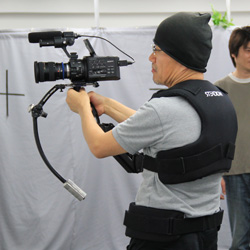 As the case with modes, there are also two main operator positions when it comes to using camera stabilizers: missionary and Don Juan.
As the case with modes, there are also two main operator positions when it comes to using camera stabilizers: missionary and Don Juan.
In the first case, the camera and the operator are both facing forward, while in the latter the camera points behind the operator. While this is the direction of the camera, the operator faces forward.
So, what is actually the difference between the two? The mode of the video stabilizer is a term that refers to the mounting of the camera and this is independent of the position of its operator. In the case of positioning, this includes the interplay between three participants of the shooting: the camera, the operator and the rig.
Steadicam or No Steadicam
Before we introduce you to some video stabilizer products and their reviews, we first need to help you determine whether you need a Steadicam as a part of your video making package or not. For this purpose, we are going a bit deeper in the purpose and the abilities of the Steadycam.
The Pros of Steadicam
- Stability
This is perhaps the best feature of every camera stabilizer out there. When you use a Stedicam, the need to worry about remaining still in duration of the filming is no longer an issue. Sometimes you will have to shoot an action footage or fast movements, which is something you cannot easily do if your camera is not stabilized. The introduction of Steadicam allows you to swivel the camera and capture anything you need.
- Positioning
Positioning your camera to shoot something high in the air or close to the ground is a highly difficult task if you don’t have a stabilizer. Steadicam now allows you to simply tilt the machine upwards or downwards and capture whatever height or point you want to include in your video. Of course, this can be done by putting a strain on the neck and the arms, but Steadicam is always the better and easier option.
- Versatility
Not every home user will enjoy versatility, but every professional will appreciate it. If you are working as a filming professional and video creator, you will need universal mounting plates to add strobes and microphones.
The Cons of Steadicam
- Price
Some find the price of Steadicam to be too steep, but when you are working in the filming or video making industry, the price should not be your main concern. After all, no professional can allow their videos to be of low quality. So, even if the price seems high for you, it is totally worth it.
- Handling
Learning how to use Steadicam is not an easy task, especially if you are a newbie in the video making world. However, if you put enough effort and time in doing so, Steadicam may turn out to be the best decision you have ever made in your camera operating profession.
Camera Stabilizer Types
There are plenty of options available on the Steadicam market, ranging in both stabilization technology and size. There are even shoulder stabilizers for a DSLR camera.
Sutefoto S40 Handheld Stabilizer Pro Version
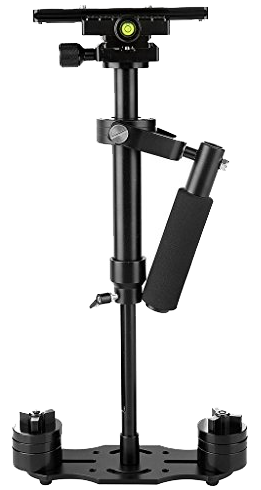 The majority of people who have picked out this machine feel that it functions amazingly for the price it carries. Professional photographers claim that calibration is necessary in order to make it work properly and in order to achieve the best possible results, one has to be patient.
The majority of people who have picked out this machine feel that it functions amazingly for the price it carries. Professional photographers claim that calibration is necessary in order to make it work properly and in order to achieve the best possible results, one has to be patient.
SUTEFOTO S40 comes with its own carrying case, high precision bearings and counterbalances. The machine is made of aluminum and coated with black powder. The operator can position it in one place or hold it in the hands. It works with most of the famous brands and DSLR cameras.
Glide Gear DNA 1000
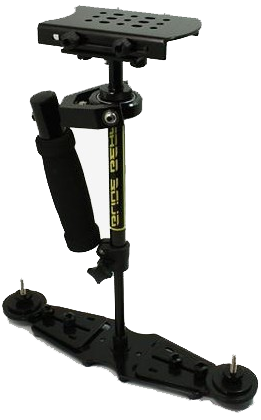 Glide Gear DNA 1000 is good Steadicam product that includes counterweight ranging from 0.7 to 1.5lbs cameras.
Glide Gear DNA 1000 is good Steadicam product that includes counterweight ranging from 0.7 to 1.5lbs cameras.
There is a possibility of accommodating more weights than one on the weight sled. Also, if more weight is necessary, common washers can also be used.
The Glide Gear DNA 1000 can create picture shots of free floating motion and the setup of balance is easy and quick. If you want to balance along the vertical axis, you just need to follow the manual’s instructions. These involve adding counterweights, removing them or telescoping the sled. Additionally, there is information on how to adjust the balance of the sled in regard to the camera.
As soon as you adjust and balance the system properly, DNA 1000’s superlight will allow you to use your camera while making it float through the air. The stabilization system takes many camera sizes of grand variety of models and fits standard Steadicam, Glide Gear and Glidecam harness systems.
The gimbal joit is free floating 3-axis, while the construction of the DNA 1000 is light aluminum. The machine is adjusted for easy setups and releases and with precision CNC parts of high tolerances. Additionally, you get wide range of compatibility for camera and precision CNC parts.
Opteka SteadyVid SV-HD Camera Stabilizer
H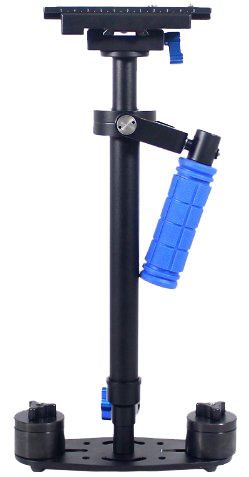 olding devices of weight that reaches 6 pounds makes this camera stabilizer quite affordable and valuable of its price. Its quick release feature allows you to easily change cameras, while the easy adjustment of angles can provide you with different shooting heights according to your preferences.
olding devices of weight that reaches 6 pounds makes this camera stabilizer quite affordable and valuable of its price. Its quick release feature allows you to easily change cameras, while the easy adjustment of angles can provide you with different shooting heights according to your preferences.
Opteka SteadyVid SV-HD’s joints are low friction made, while its bearings are crafted with the utmost high precision. There are plenty of reviews to be found online for this particular machine. The majority of people who have purchased it claim that it works exactly as explained.
Neewer Carbon Fiber Handheld Stabilizer
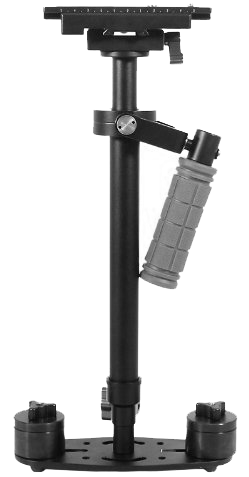 The Neewer Carbon Fiber Handheld Stabilizer allows shooting from both high and low angle. Additionally, it is especially good for capable DSLR cameras, DVs and video cameras. It allows high precision bearings and stretch adjustment, which in return improves the ratio of weight.
The Neewer Carbon Fiber Handheld Stabilizer allows shooting from both high and low angle. Additionally, it is especially good for capable DSLR cameras, DVs and video cameras. It allows high precision bearings and stretch adjustment, which in return improves the ratio of weight.
The plate is of quick release and can support cameras with 1/4” and 3/8”. Additionally, it can record different equipment’s’ dynamic balance.
The construction is carbon fiber, which provides durable and long-lasting usage. Its grip is covered with sponge, which allows the users to handle it more comfortably. Its maximum load is approximately 3 kilos.
Videook Carbon Fiber Stabilizer
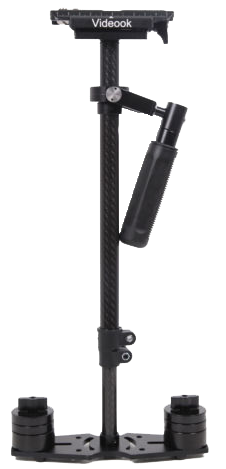 Videook Carbon Fiber Stabilizer will fit the majority of DSLR cameras ranging between 0.2 and 3Lbs. It is especially made for those who want to shoot videos while moving. This particular product comes with a soft bag and only 2.2 lb, which means it is easy to transfer and carry.
Videook Carbon Fiber Stabilizer will fit the majority of DSLR cameras ranging between 0.2 and 3Lbs. It is especially made for those who want to shoot videos while moving. This particular product comes with a soft bag and only 2.2 lb, which means it is easy to transfer and carry.
The quick release plate is easy to adjust and setup and is included in the package. The Videook Carbon Fiber Stabilizer can take part as handheld camera, which will come in handy in any projects you want to shoot. The package also includes cell phone clip, carrying bag and 6 balance weights.
The camera stabilizer can be used by holding the handle and pulling the base horizontally, after which it should be left to drop. The time it swings horizontal to vertical should be calculated. The shaft can be adjusted both up and down so that you can reach a 3 second drop time.
Steadicam Smoothee
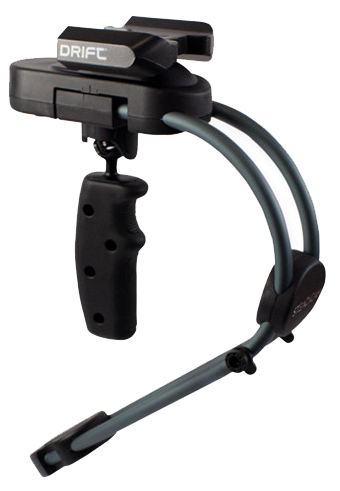 Specifically engineered and designed to work with Go Pro HD Hero and iPhone 5, the Steadicam Smoothee is the right pick for those who need incredible video without shakes. This particular product is built to be portable and small, which does not only allow you to travel with it, but can also let you go everywhere the scene is taking you.
Specifically engineered and designed to work with Go Pro HD Hero and iPhone 5, the Steadicam Smoothee is the right pick for those who need incredible video without shakes. This particular product is built to be portable and small, which does not only allow you to travel with it, but can also let you go everywhere the scene is taking you.
The Steadicam Smoothee has quick release mount which allows users to swap the connections of camera between tripods and the Steadicam. It is specifically designed for Go Pro HD Hero and Hero 2 and iPhone 5, but its quick release mount can also serve as a stand. Additionally, it has the ability to be mounted to tripods that have 1/4×20” camera mount.
Included in the package is a guide in form of a DVD, which serves to let you know how the best possible shots can be taken. Additionally, this package includes a carrying strap. In operating configuration, the Smoothe is approximately 20.3 x 36.8 x 6.4 cm.
DJI Phone Camera Gimal OSMO MOBILE
 DJI Phone Camera Gimal Osmo Mobile uses SmoothTrack technology and the three-axis gimal stabilization signature of DJI. This Steadicam enables users of smartphone to make high quality, stable videos when they move.
DJI Phone Camera Gimal Osmo Mobile uses SmoothTrack technology and the three-axis gimal stabilization signature of DJI. This Steadicam enables users of smartphone to make high quality, stable videos when they move.
The DJI GO app allows people to live stream and share all made photos and videos on social networks, while the DJI ActiveTrack allows them to tap the screen and take shots of moving objects.
The precision of the Osmo Mobile goes down to 0.03 degrees of accuracy. The DJI’s SmoothTrack technology allows it to compensate for small movements and shaking, which makes a chance for users to capture cinematic shots.
There are various modes that can be accessed by simply using the trigger control. Additionally, you can switch between all cameras on the phone. The machine is compatible with the majority of recent models of smartphones such as iPhone 5, iPhone 6, iPhone 6s, Samsung Galaxy S7 and Huawei Mate 8. Also, it accommodates all iOS and Android smartphones that have a width between 2.31 and 3.34 inches.
The four different modes of operation include standard, flashlight, underslng and portrait. OSMO MOBILE has Bluetooth connection and is compatible with the DJI Osmo accessories.
Interesting Facts
- The newest Steadicam generation is the Tango. Right now, this is the most modern camera stabilization system, created to be body supported. The tango has horizontal mechanisms that allow users to move the camera freely. While they are doing so, they can freely stay horizontal. Additionally, the operator of the machine can change modes without any additional alterations. The dimensions of the Tango are not limited only to ups and down. They are also combined to go in depth and through certain obstacles.
- The lightest Steadicam i.e. the smallest one can be used with vest and support arm. This machine is called the Merlin and is light enough to be held with 5.5 pounds cameras. Additionally, this Steadicam can carry cameras that weight up to 3.2 kg when they are used with the arm.
There is a possibility of folding up the Merlin and carrying it in camera bags of medium size. The latest Merlin configuration weights only 0.35kg.
The Merlin is most commonly used by professionals that combine still and motion photography HDSLR cameras, but since it has co separate monitor carrier facility, the cameras that are suitable for this product must have their own built-in monitors.
- In 2012 a lighter model called the Smoothee was introduced. It is designed with a tubular frame that can support GoPro cameras with attached viewfinder monitor and 4 through 5S Apple iPhones.
- An even smaller Steadicam called Curve is available for use with GoPro cameras 2, 3 and 3+. This Steadicam is made of curved aluminum slash and is now available in outlets.
Steadicam is one of the most important inventions of filmmaking and photography. The advancement in technology regarding this amazing product since its first appearance allows you to pick from a grand variety of different Steadicam products. Additionally, the prices vary according to the product, which allows you to receive quality stabilizer for a suitable price.
If you are not a professional in taking videos and photos, you may not be interested in this particular product. However, being a professional in the field simply does not allow people to ask for anything less than the best. As professionals, you must make sure that every video and shot you take is perfect, regardless of the trouble you have to go through while making it. Luckily, there are plenty of choices to pick from right now that can make your life much easier. All you have to do is learn how to handle the Steadicam. After you have mastered the functions of the Steadicam you purchase, you will be able to shoot any shot you want to, without having to worry about unsteady, blurry or jarring recordings.
So, what are you waiting for? Steadicam is just a click away from being your new best friend in making steady, perfect videos.
